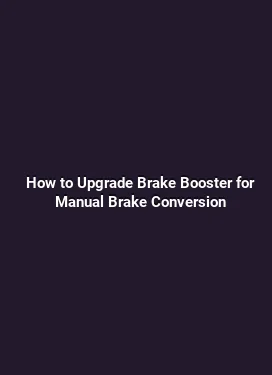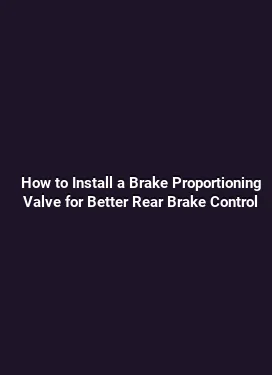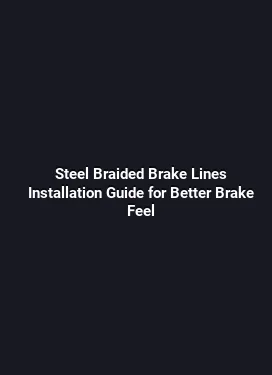How to Install Wilwood Superlite 6-Piston Brake Kit: A Complete Guide for Brake Systems Enthusiasts
The Wilwood Superlite 6-piston brake kit is designed for high-performance applications, offering strong clamping force, improved pedal feel, and reliable stopping power. This guide provides a detailed, practical approach to installing the kit on compatible vehicles, covering preparation, component inspection, removal of existing hardware, precise mounting, fluid management, bedding procedures, and upkeep. The aim is to help enthusiasts achieve a safe, reliable installation with real-world tips that go beyond basic instructions.
Makale içindeki ilk H2 başlık buraya gelmeli

Before diving into installation, it is crucial to understand the kit’s components and how they integrate with the surrounding brake system. The Wilwood Superlite 6-piston kit generally includes 6-piston calipers, performance rotors, bracketry for mounting, braided stainless steel brake lines, mounting hardware, and a recommended caliper fluid compatibility profile. The kit’s performance characteristics stem from the caliper’s six-piston configuration, which achieves wide contact with the rotor surface, distributing clamping force evenly and reducing heat buildup during aggressive braking. When selecting a setup, attention should be paid to rotor diameter, thickness, hat design, and center bore, ensuring a precise fit with your vehicle’s hub assembly and wheel clearance.
In high-performance or track-oriented builds, brake bias, rotor perforation, and pad compounds are chosen to optimize fade resistance and response. The choice of rotor type—slotted, cross-drilled, or plain—depends on driving style and environmental conditions. It’s common for racers and enthusiasts to pair these calipers with high-friction, race-grade pads and appropriate brake fluid to sustain consistent performance under strenuous braking cycles.
Makale içindeki ilk H3 başlık buraya gelmeli

Compatibility is the backbone of a successful installation. Before unboxing the kit, verify the vehicle’s hub spacing, bolt pattern, and rotor thickness to prevent fitment issues. A common challenge is wheel clearance: large calipers can collide with wheel spokes or lug stud locations. An essential step is to measure the existing rotor diameter and offset, then compare with the new rotor’s dimensions. In cases where clearance is tight, alternatives such as different wheel offsets or rotor thickness reductions may be necessary, but only if confirmed safe by the vehicle’s braking system design and the kit’s specifications.
Parts and Tools Needed for a Smooth Installation
A successful installation relies on having the right tools and replacement parts on hand. Standard tools include a torque wrench, a set of metric and SAE socket wrenches, hex keys, and a breaker bar. A high-quality line wrench helps avoid damaging braided stainless lines during disconnects. Additional items include the Wilwood-provided hardware, high-temperature brake fluid compatible with the system, a brake fluid bleed kit, a brake caliper grease, and a dedicated torque specification chart for your vehicle model. It’s advantageous to have a clean, organized workspace with magnetic trays for fasteners, a digital caliper for precise measurements, and a stable jack and stands for vehicle support.
Make sure to prepare fresh brake fluid of the recommended type. Brake fluid is hygroscopic and absorbs moisture over time, which can lead to reduced boiling points and inconsistent braking performance. Using new fluid during bleeding and bedding-in processes helps maintain consistent pedal feel and prevents moisture-induced corrosion within the system.
Kalibrasyon ve güvenlik odaklı adımlar
Before disassembly, take high-resolution photos of the existing brake assembly from multiple angles. This visual record helps during reassembly, especially when routing brake lines, positioning brackets, and aligning hardware. Safety equipment, including eye protection and gloves, should be worn during all steps. If the vehicle is equipped with an ABS module or electronic brake systems, consult the vehicle’s service manual to understand any electronic constraints or required reset procedures after installation. While this guide focuses on mechanical installation, awareness of the whole system is essential for long-term reliability.
Preparation: Vehicle Assessment and Kit Readiness
Careful assessment of the vehicle’s braking system is the foundation of a successful upgrade. Begin by checking the condition of rotors, pads, and old brake lines. If rotors show excessive wear or scoring, plan for resurfacing or replacement. Inspect wheel bearings, hubs, and dust shields for damage or excessive wear that could hinder proper rotor seating. When removing the stock components, label connectors, lines, and bolts for accurate reassembly. The Wilwood kit’s compatibility is most often tied to hub bore size, rotor thickness, and caliper mounting spacing, so verify these dimensions against the vehicle’s specifications before proceeding.
Additionally, assess the vehicle’s weight distribution and brake balance. A significant upgrade in caliper capacity can shift the braking dynamics, potentially requiring suspension tuning or bias adjustment. If changing wheel size or tire compound, account for how the new kit will behave under different traction conditions. Having a plan for bedding-in and calibration ensures a smooth transition from stock performance to enhanced braking capability.
Malzeme ve montaj için temiz bir çalışma alanı oluşturma
A clean workspace reduces the risk of losing small parts and ensures inspection after steps. Lay out brackets, bolts, and fasteners in labeled trays. Keep brake fluid containers closed when not in use to minimize moisture absorption. A well-lit area with a mirror or camera can help inspect hard-to-reach components during installation. For vehicles with heat shields or underbody covers, plan for temporary removal to access mounting points without damaging surrounding components.
Disassembly: Removing Old Components with Minimal Risk
Carefully remove the wheels and inspect the caliper mounting points. Document the orientation of the existing calipers and brackets, as this informs the new mounting arrangement. If brake lines are connected to the master cylinder or ABS modulator, note the fittings and routing. Use a line wrench to disconnect braided hoses to minimize the risk of kinking or thread damage. Cap the lines to prevent contamination and keep the system clean during the swap.
With the old components removed, measure the rotor diameter, rotor thickness, and hub surface flatness to assess any interference with the new kit. If rotor thickness is insufficient or hub runout is excessive, address these issues before proceeding to prevent rotor runout and uneven pad wear in the new setup.
Kalibrasyon ve kalıcılık için adımlar
During disassembly, inspect the brake system’s hydraulic lines and seals for signs of wear, cracks, or leaks. Replacing perishable components such as flexible lines and O-rings can prevent leaks once the new kit is installed. If the vehicle is equipped with a hydraulic handbrake, verify that its linkage will not interfere with the new calipers and lines. Documenting the original routing helps ensure consistent line placement and helps locate potential chafing points in the new configuration.
Installation Procedure: Mounting the Wilwood Superlite 6-Piston Kit
Start with mounting brackets and calipers in their respective positions, ensuring that the caliper clearances align with the rotor edge and the wheel face. Tighten mounting bolts to the manufacturer’s recommended torque using a calibrated torque wrench. The precise torque prevents caliper misalignment and assures correct rotor clamping force. Route braided lines with careful attention to avoid sharp bends and ensure flexibility at the connection points. Secure all line ends with appropriate clamps and verify there is no contact with the wheel or suspension components during full suspension travel.
When attaching the rotors, verify the rotor seating is flush against the hub to minimize rotor runout. Start with aligning the rotor’s set screws or mounting screws (if included) and then torque the rotor retaining bolts to spec. Rotate the wheel by hand to confirm there is no drag or rubbing between the rotor and caliper housing, and ensure rotor runout is within the vehicle's allowed limits.
Bleeding and Fluid Management
Bleed the brake system using the recommended brake fluid type. Begin with the caliper farthest from the master cylinder and work toward the closest. Use a two-person bleeding technique or a brake bleed kit to maintain a steady flow and scrub out air. After bleeding, refill the reservoir to the proper level and recheck for any leaks at all connections. Once the system is bled, pump the brake pedal to ensure a firm and consistent feel. A proper bleed ensures that the six-piston configuration translates to even engagement across the rotor surface, delivering predictable bite and stable pressure under heavy braking.
Bedding the brakes follows a controlled sequence: perform several moderate stops from a moderate speed, then gradually perform higher-temperature stops while allowing the brakes to cool between cycles. This process helps the pads and rotors establish a strong contact patch and a heat-resistant protective layer. The bedding procedure also reduces the risk of glazing and pad transfer on the rotor surface, promoting consistent friction characteristics on the track or daily driving conditions.
Post-Install Evaluation: System Check and Fine-Tuning
After installing the Wilwood Superlite 6-piston kit, perform a thorough inspection for any signs of leaks, loose fasteners, or misaligned components. Recheck rotor runout, hub cleanliness, and wheel clearance to confirm proper seating. Test the pedal depth and response at low speed in a controlled environment before engaging higher speeds. If the pedal feel is spongy or inconsistent, re-bleed the system and verify there are no air pockets in the lines. In some cases, a small adjustment in brake bias can improve overall balance, particularly if the vehicle exhibits under- or over-braking on front or rear wheels.
Maintenance is essential for longevity. Regularly inspect caliper pistons for sticking, check for brake fluid moisture content, and monitor pad and rotor wear. If rotor wear becomes uneven or grooves appear on the rotor surface, measure and assess whether resurfacing or rotor replacement is necessary. A meticulous maintenance routine ensures the kit’s performance remains consistent across different driving scenarios, from daily commuting to demanding track sessions.
Upgrades, Compatibility, and Real-World Use Cases
The Wilwood Superlite 6-piston system is highly adaptable for various applications, including street performance cars, street-legal track cars, and competitive racing builds. Real-world use cases often involve pairing the kit with high-friction pads that are optimized for both street and track conditions. Brake fluid choices are influenced by climate, driving style, and ambient temperatures; in hotter climates or more aggressive environments, a silicone-based or synthetic formulation with higher boiling points may be preferred. Additionally, rotor material selection can impact heat dissipation and rotor wear, with advanced composites or treated alloys offering improved durability in high-stress conditions.
When upgrading, it’s essential to consider wheel clearance, hub compatibility, and brake line routing. Some installations may require a minor change in wheel offset or a modification to the wheel wells to ensure full clearance during cornering and braking. For those seeking to optimize performance further, combining the Wilwood kit with balanced tire grip and suspension tuning can yield a cohesive braking experience with predictable feedback and fade resistance across a wide range of driving scenarios.
Yol Gösterici ve Bilinçli Seçimler
Practical considerations include ensuring the brake system remains compliant with vehicle safety standards and local regulations. Documentation of part numbers, installation steps, and torque specs helps in future maintenance and potential warranty coverage. A well-documented installation can also aid other enthusiasts who may refer to the setup for their own vehicles, allowing a shared knowledge base within the braking community.






